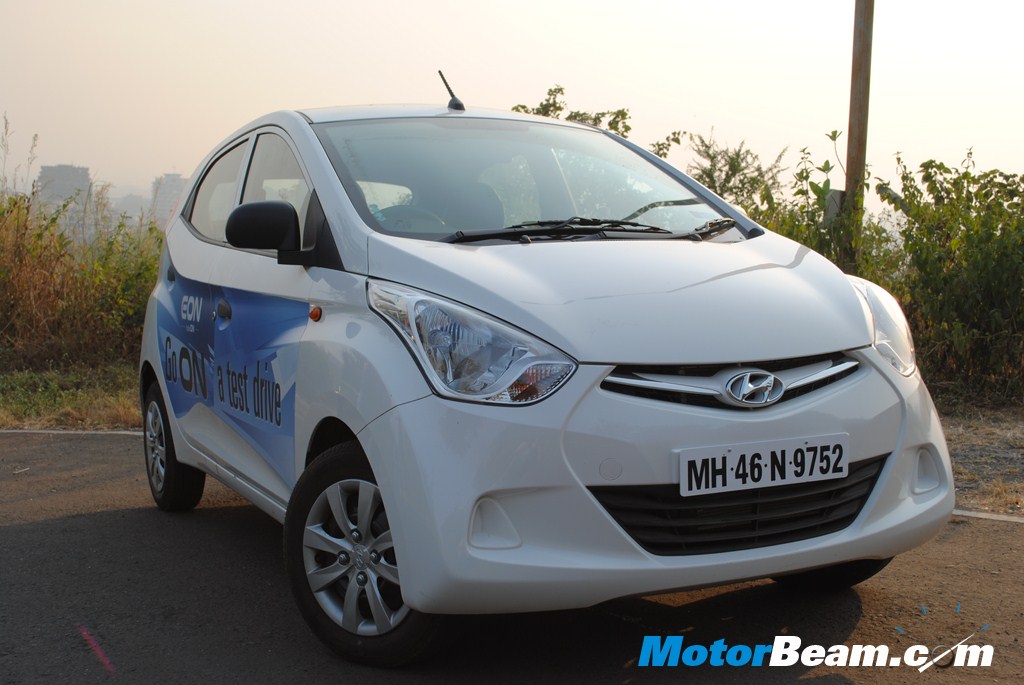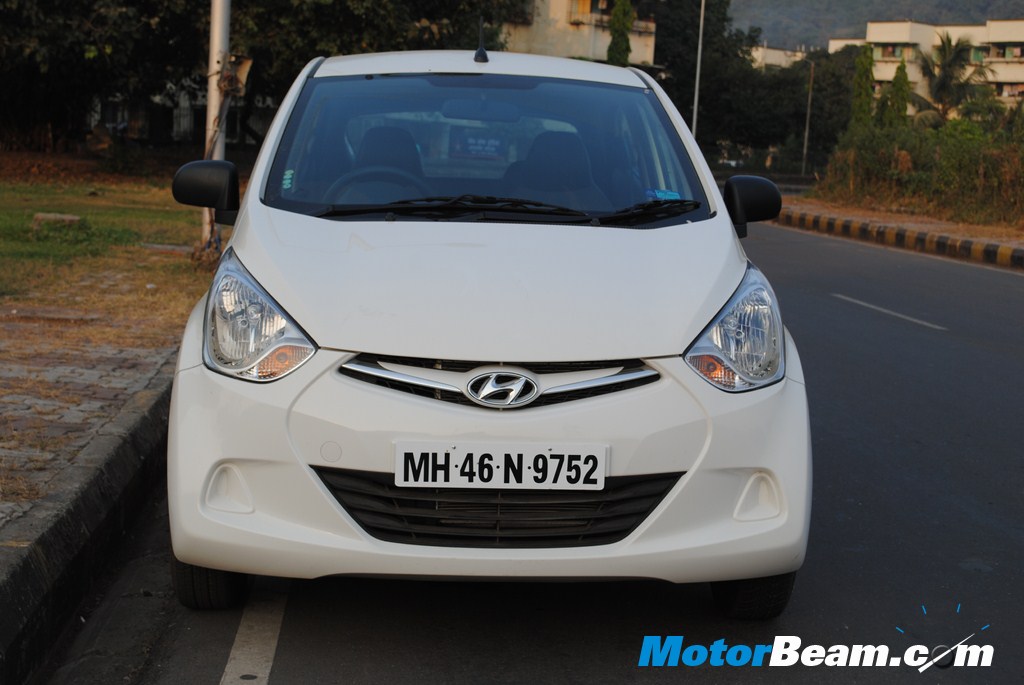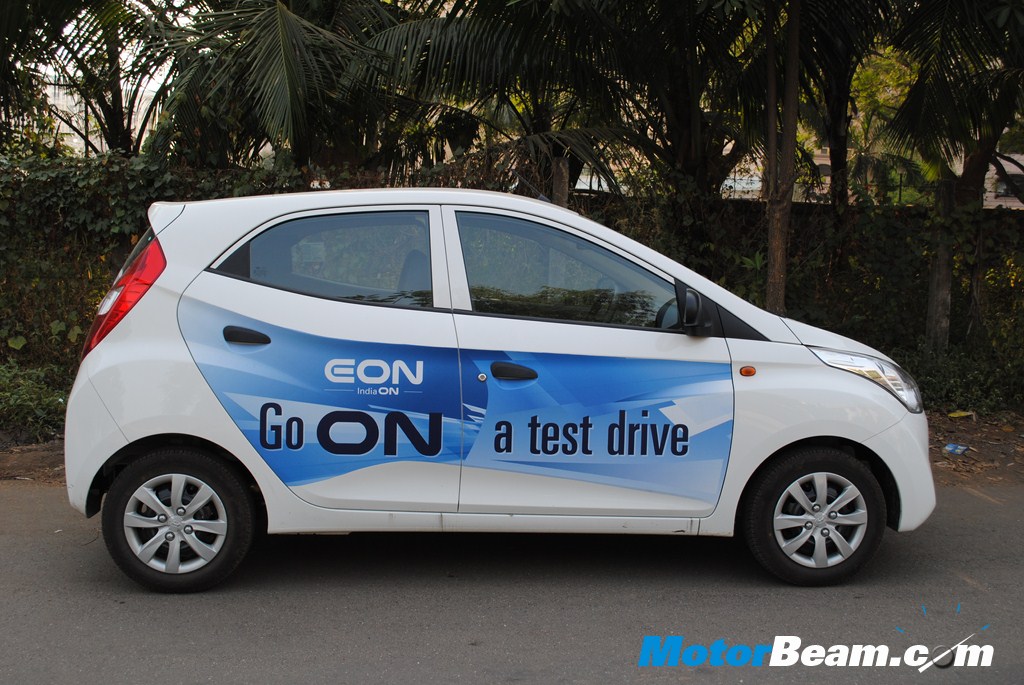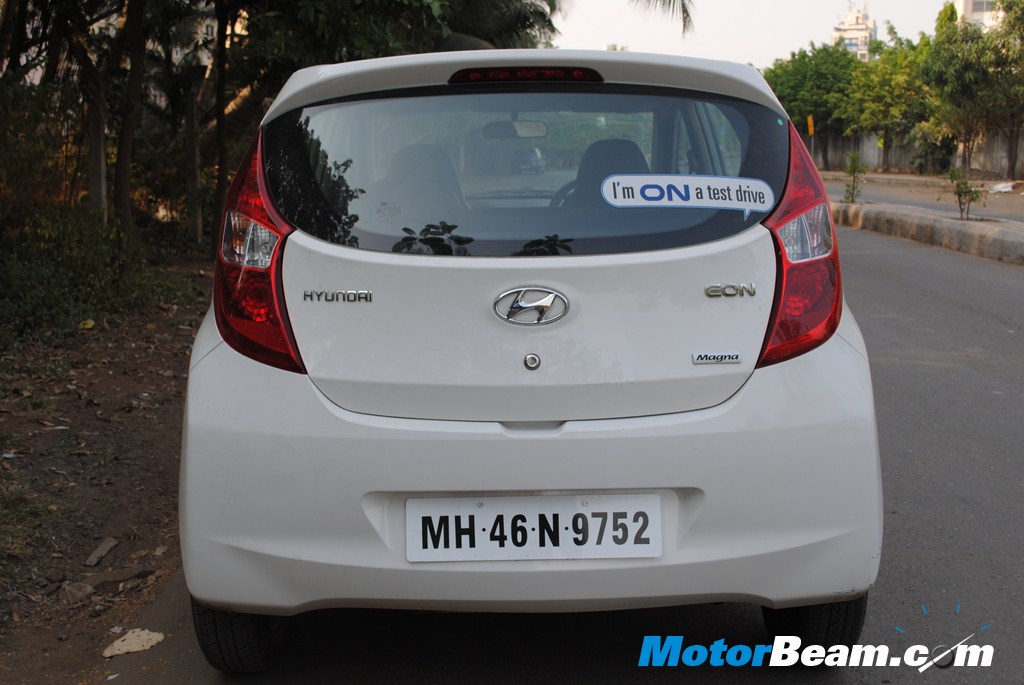
Car tested: 2011 Hyundai Eon Magna
Price OTR Mumbai: Rs. 3,94,071/-
The entry level hatchback segment accounts for maximum sales in the industry and obviously so. The most popular entry level car has been the Maruti Suzuki Alto since the time it was launched and it evens holds the record for the most selling car in the world. Majority of people who buy a car in this segment primarily use it to transport themselves between place A and B and nothing much is really expected from it as long as it is cheap to maintain and extremely fuel efficient. The Nano has taken away the tag of the cheapest car of late but the numbers have been coming in from Maruti Suzuki. The Hyundai Eon is made to dethrone the Alto and looks alone can do it but we take it on an extensive test to see if its as good as it looks.
Exteriors – Based on the looks alone, the Eon does not come across as an entry level car. The design is captivating enough to pick the Hyundai Eon over the competition. Hyundai latest Fluidic design has rubbed off well on the car and its comes across as a modern car which makes a style statement. The front has the typical hexagonal family grille and many may mistake it to be the i10 at first glance. The headlamps swoop all the way back to the hood and prominent wheel arches are a part of the Fluidic philosophy. The Sportz variant comes with triangular fog lamps, the Magna, on the other side has provision to get it done as an after market fitment. Bulging wheel arches add muscle and complement the design.
The side has numerous sculpted lines which form the basics of the fluidic design. The waistline rises at the rear door to give a sporty modern look while the roofline slopes slightly towards the rear. Notice the integrated rear spoiler on the Hyundai Eon, it’s standard across all variants. The wheel caps seen in the picture can almost pass for alloy wheels. The tall boy design ensures that even the tallest of people will have sufficient headroom.
The rear bumper bulges outwards but its the rear tail lamps cluster which looks gorgeous. High mounted stop lamp is integrated with the spoiler and there is no mistaking the Eon from behind. It may be misunderstood for the i10 upfront but its has its own personality in the end, quite literally.
Interiors – The picture tells the story but its my job to elaborate. Interiors are by far the best in the segment, never before have we seen such good quality interiors in a car which sits in this particular price point, infact it can put cars much higher up the segment to absolute shame. Get inside and the Hyundai Eon oozes of quality, feel fresh interiors, great plastic quality and the 2 tone beige and greyish black combination just enhances the appeal. No uneven panel gaps and fabulous fit and finish. It wont be out of place to mention that the Alto, the largest selling car in the segment, does not even come close to matching the quality. The hexagonal theme is carried onto the dashboard, which has a futuristic sporty design. A large storage area is placed above the glove box for odds and ends.
An extremely spacious and practical glove box.
The steering feels good to hold with the thumb rests. Notice the centre of the dashboard, this central space has been catered to keep idols and is called the deity space by Hyundai. The top end Sportz variant get a 3 spoke steering. Height adjustable steering offered on the Magna and Sportz models, a very convenient feature. Steering also gets tilt adjustment.
Two tone door trim with large map pocket. Power window switches conveniently placed.
The audio unit comes with two speakers as standard with provision to install two more at the back and plays CD, USB and Aux. Sound quality is fair and USB/Aux ports are placed right in the head unit as shown. The air conditioner is very efficient and chill the cabin in no time at all. On a hot Sunday afternoon, the a/c was cooling so well that i had to get the fan to the minimum speed. Without any doubts, the a/c is far more efficient than the competition.
Most aftermarket rear speakers are mounted on the parcel tray, which not only has wires crowding the boot but also eat up on the parcel tray utility. Hyundai has catered to this, you can fit after market rear speakers in the space provided.
Both front and rear seats are mix of fabric and art leather. The front seats incorporate an integrated headrest and are comfortable. Back support is adequate but due to the size of the car, the seat width is sufficient for an average built person and a heftier person might end up wanting for more width. Underthigh support is average and overall the seats are reasonably comfortable, though i must admit, being a six footer in height, it did take me awhile to get feel at home.
Rear legroom is just about adequate. The front seats have been adjusted to my driving position thus it looks much less than it is. We are not comparing this to the Nissan Sunny hence the legroom is fair in its own segment.
Rear seats lack under thigh support as illustrated. Headroom is just enough for me and this is due to the roof line sloping backwards and more importantly my height. As mentioned earlier, the front seat is adjusted to my driving position but when my driver (height 5’7″) was at the wheel, i had much more room behind and it was much more comfortable.
Boot space measures 215 liters and is more than adequate. Notice that metal is exposed on the sides, cost cutting?
The rear seats don’t fold 60:40 but can be folded in one piece to create more room.
On the Move – Start the ignition and the engine settles into an idle. Engine vibration does creep inside the cabin due to the 3 cylinder motor but its not too much, Hyundai has incorporated a counter balancer to keep the vibrations at bay. This 3 cylinder motor delivers reasonable performance but gets too loud at higher revs. NVH levels could have been better.
Gear lever vibrates continuously but you end up getting used to it. Notice the large storage area just in front of the lever. 12 V power outlet is provided to charge your mobile on the go. Built quality is solid and even on the bumpiest roads, there were no squeaks or rattles.
No tachometer but there is a gear shift indicator which will guide you to slot into the required gear at that given speed for optimum fuel efficiency. In the picture above, i was doing almost 60 in the 2nd gear and the gearshift indicator is urging me to go into 3rd. The instrument cluster is well laid out with green lights showing the fuel level and engine temperature instead of the conventional needles.
Ride, Handling and Braking – A car in this segment is certainly not tuned to be a outright handler, regardless, the Eon does fairly well. Steering is light and comes handy in bumper to bumper traffic, however it remains light as you gain speed and becomes overly sensitive at high speeds, feedback is passable but i was pleasantly surprised by the high speed stability of this car. Even at 110 kmph it felt well planted provided you keep a firm hold of the steering, slight movement and the car will twitch, not dangerously though. On the other hand, the Alto and the Spark, do not inspire enough confidence at triple digits speeds and feel unsafe, while the Eon easily scores over its rivals as far as high speed feel is concerned. To add to the safety, the Sportz version comes with drivers side airbag as standard, the first in the segment.
At low speeds the ride is complaint on good tarmac and slight undulations are taken with ease, it only when you get to the craters, the ride tends to be bouncy, a typical trait of Hyundai cars and rear passengers are affected the most. Ground clearance at 170 mm is good for Indian conditions and we did not scrape the underbelly even once.
Braking is by far the best in the segment, though there is no ABS offered on the Eon, not even as an option, the brakes are crisp and bite easily. Braking from 120 kmph, the car was quite stable getting to zero, no sideways movement, stopping in a straight line. I did end up locking the tyres and its the tyres which give up on the grip much before the brakes. Overall, impressive braking performance. I was driving the Magna variant and it comes shod with 155/80/13 tyres. The lower variants come with 145 spec tyres and its advisable to upgrade the rubber for better braking performance and safety.
Performance – The Eon is powered by a 3 cylinder, 814 CC motor which churns out 55 BHP @ 5500 rpm and 75 Nm torque @ 4000 rpm. Its effectively the 1.1 litre Santro engine sans a cylinder. This not only cuts down the manufacturing cost but also gives the Eon class leading fuel efficiency of 21.1 kmpl (ARAI certified). 3 cylinder engines have pretty much been the norm in small hatchbacks. Maruti uses a 998 cc engine to power the Alto, Wagon R and the Estilo, even higher up the segment, the Polo twins (petrol and diesel) & Micra (petrol) are doing rounds on a 3 pot motor. The point which comes through is that 3 cylinder engine are more fuel efficient than their 4 cylinder counterparts and with fuel costs spiraling, manufacturers are trying their best to maximize the fuel efficiency.
Low end grunt is just about ok but the mid range and high end punch make up for it. The Eon will hit 100 kmph without difficulty and thereon you will will feel the engine running out of breath, 120 is attainable but then on its a struggle. The engine note gets extremely loud at higher rpms with vibrations creeping in. Top speed should be around 130 kmph. Overtaking on the highway will need a few downshifts but should be relatively easy. Let me remind you that the Eon is no supercar and these figures are fairly competent for the average person who is likely to buy this car. We expect it to deliver an efficiency of about 17 – 18 kmpl, city and highway combined. It has a relatively small fuel tank of only 32 litres, which should be good for an approximate range of 550 km on a single fuel tank.
Conclusion – The Eon has shaken up the segment in terms of customer expectation and it offers the best in class quality, fuel efficiency, features with truly modern styling. Its immediate competitors, the Alto and Sprak clearly look outdated in comparison. Its surprising how Hyundai has manged to price this car so competitively and still keep up with the quality. There is no waiting period either and its readily available off the shelf. Hyundai has got a winner on its hands here and there is no doubt that its the best best buy for the buck.
Whats Cool
* Built Quality
* Features (Drivers Airbag, USB/AUX, Gear Shift Indicator, Keyless entry)
* Styling
* Fuel Efficiency
* Value for Money
Whats Not So Cool
* Gear lever vibration
* NVH
* Steering feedback at high speeds
Hyundai Eon Specifications : –
* Engine – 3 cylinder, 814 cc, 9V, SOHC
* Power – 55 BHP @ 5500 rpm
* Torque – 75 Nm @ 4000 rpm
* Transmission – 5 speed manual
* Top Speed – 130 kmph
* Fuel Consumption – 15 kmpl (City), 18-19 kmpl (highway)
* Fuel Type – Petrol
* Suspension – Mcpherson strut with coil spring and anti roll bar (Front), Torsion beam axle with coil spring (Rear) with Gas shock absorbers
* Tires – 145/80/12 Tubeless radials (D-lite, D-lite (O), Era) & 155/70/13 Tubeless Radials (Magna, Magna (O) & Sportz)
* Brakes – Front Discs & Rear Drums. NO ABS
* Safety – Drivers Side Front Airbag, Keyless Entry with Central Locking
Hyundai Eon Dimensions : –
* Overall length x width x height – 3495 mm X 1550 mm X 1500 mm
* Wheelbase – 2380 mm
* Front/Rear Track – 1386/1368 mm
* Ground clearance – 170
* Boot Volume – 215 liters
* Fuel Tank Capacity – 32 liters







